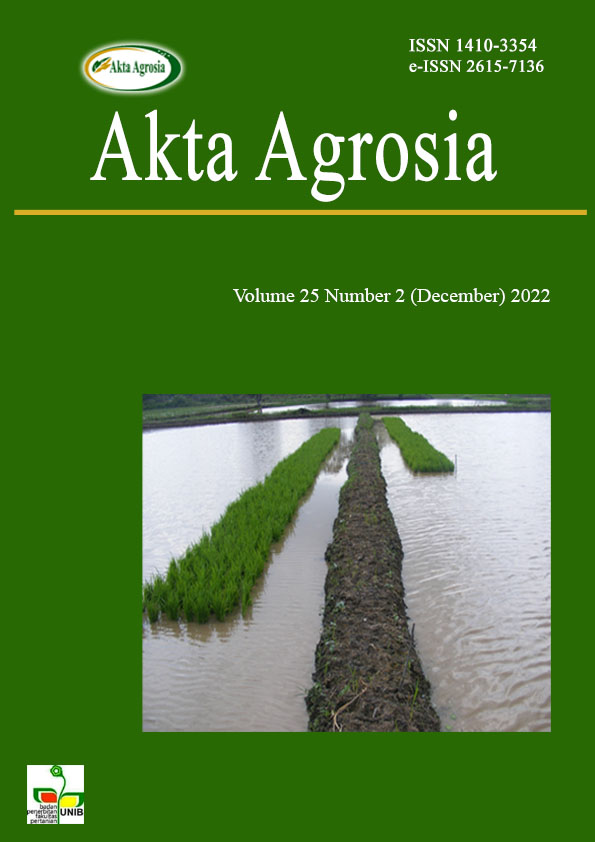Main Article Content
Abstract
Long-term use of chemical pesticides in high doses might result in chemical residues. Therefore, eco-friendly plant pest control should be getting more attention. To do so, one might consider the utilization of microorganisms that have the enzymatic ability to destroy the pest's body structure. This study aimed to explore the isolates of Bacillus sp. from coffee beans as a plant pest control candidate. Bacillus could be considered due to its ability to produce protein crystals and extracellular enzymes. Three isolates are obtained from isolation from coffee beans: Bacillus sp. 1; Bacillus sp. 2; and Bacillus sp. 3. These isolates have the enzymatic character of protease, chitinase, and lipase. The results of the bioassay test on larvae of Plutella xylostella (Lepidoptera order) showed that these isolates were able to cause larvae death within 48 hours.
Article Details
Copyright (c) 2023 Christina Nugroho Ekowati, Maria Denada Siallagan, Sumardi Sumardi, Emantis Rosa

This work is licensed under a Creative Commons Attribution-ShareAlike 4.0 International License.
Authors who publish with this journal agree to the following terms:
- Authors retain copyright and grant the journal right of first publication with the work simultaneously licensed under a Creative Commons Attribution License that allows others to share the work with an acknowledgement of the work's authorship and initial publication in this journal.
- Authors are able to enter into separate, additional contractual arrangements for the non-exclusive distribution of the journal's published version of the work (e.g., post it to an institutional repository or publish it in a book), with an acknowledgement of its initial publication in this journal.
- Authors are permitted and encouraged to post their work online (e.g. in institutional repositories or on their website) prior to and during the submission process, as it can lead to productive exchanges, as well as earlier and greater citation of published work (See The Effect of Open Access).
References
- REFERENCES
- Agustien, A. 2010. Protease Bakteri Termofilik. UNPAD PRESS. .
- Bestari, N.C., dan Suharjono. 2015. Uji Kualitatif dan Kuantitatif Isolat Bakteri Lipolitik dari Limbah Cair Pabrik Pengolahan Ikan Kecamatan Muncar Banyuwangi. Jurnal Biotropika, 3(3):151 -155
- Cavaglieri L., Andres L., Ibanez M., Etcheverry M.. 2005. Rhizobacteria and their potential
- tocontrol Fusarium verticillioides:effect of maize bacterisationand inoculum density.
- Antonie Van Leeuwenhoek.
- Federici, Brian A., Hyun-Woo Park, dan Yuko Sakano. 2006. Insecticidal Protein Crystals of Bacillus thuringiensis. Microbial Monogr. doi: 10.1007/7171.
- Firliani, W., A. Agustien, and F.A Febria. 2015. Karakterisasi Bakteri Termofilik Penghasil Enzim Protease Netral. Journal Biologi Universitas Andalas 4(1):9-14
- Gupta, R., Q. K. Beg and P. Lorenz. 2002. Bacterial alkaline proteases: Molekuler approaches and industrial applications. Applied Microbial Biotechnology, 59: 15 - 32
- Nurdin, G. M, Mubarik, N. R, Sudirman Li. 2016. Selection of chitinolytic bacteria as biological control of Colletotrichum capsici. Malaysian Journal of Microbiology.12(1): 35-42
- Siallagan, M. D., Ch. N. Ekowati, Sumardi, dan E. Rosa. 2020. Deteksi Kristal Protein Pada Isolat Bacillus sp. dengan Pewarnaan Coomassie Brilliant Blue. Biospecies, 13(2).
References
REFERENCES
Agustien, A. 2010. Protease Bakteri Termofilik. UNPAD PRESS. .
Bestari, N.C., dan Suharjono. 2015. Uji Kualitatif dan Kuantitatif Isolat Bakteri Lipolitik dari Limbah Cair Pabrik Pengolahan Ikan Kecamatan Muncar Banyuwangi. Jurnal Biotropika, 3(3):151 -155
Cavaglieri L., Andres L., Ibanez M., Etcheverry M.. 2005. Rhizobacteria and their potential
tocontrol Fusarium verticillioides:effect of maize bacterisationand inoculum density.
Antonie Van Leeuwenhoek.
Federici, Brian A., Hyun-Woo Park, dan Yuko Sakano. 2006. Insecticidal Protein Crystals of Bacillus thuringiensis. Microbial Monogr. doi: 10.1007/7171.
Firliani, W., A. Agustien, and F.A Febria. 2015. Karakterisasi Bakteri Termofilik Penghasil Enzim Protease Netral. Journal Biologi Universitas Andalas 4(1):9-14
Gupta, R., Q. K. Beg and P. Lorenz. 2002. Bacterial alkaline proteases: Molekuler approaches and industrial applications. Applied Microbial Biotechnology, 59: 15 - 32
Nurdin, G. M, Mubarik, N. R, Sudirman Li. 2016. Selection of chitinolytic bacteria as biological control of Colletotrichum capsici. Malaysian Journal of Microbiology.12(1): 35-42
Siallagan, M. D., Ch. N. Ekowati, Sumardi, dan E. Rosa. 2020. Deteksi Kristal Protein Pada Isolat Bacillus sp. dengan Pewarnaan Coomassie Brilliant Blue. Biospecies, 13(2).
